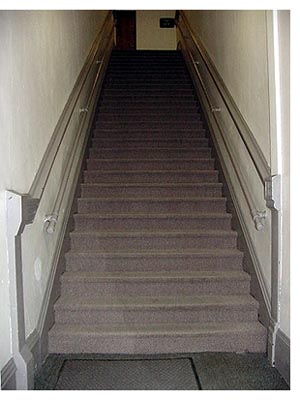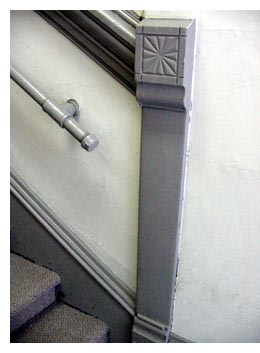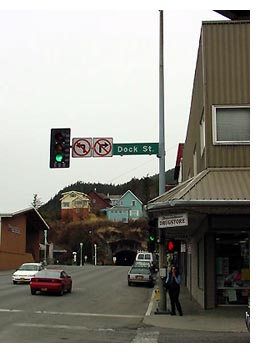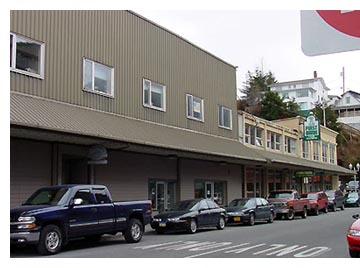 A Very Special Ketchikan Hotel By June Allen April 9, 2002
As we trooped up the ramp toward the terminal, big kids holding little kids' hands, we were met by longtime school board member O.M. Lien, who was warmly welcoming. My husband would be teaching at the Ketchikan Community College, then located in the Zimmerman building (now home to the Gateway Borough offices). I would look for work. We had an apartment waiting for us in the Tongass Towers, but it was not quite ready. For that first night we would be staying at the Stedman Hotel. There was a PTA convention of some sort in town and every hotel in town was jammed.
My husband and I would sleep in one twin bed, the two older girls would sleep head-to-foot in the other, and the two- and four-year-old girls would share the rollaway. It was beyond crowded! With our suitcases at first sharing bedtop space with ourselves, we had to get undressed and into nightwear sitting or - in the case of the little girls - standing and jumping on the beds. And of course they all had to go to the bathroom! Down the hall we trooped at that late hour, in nighties or jammies, shushing each other. As we walked, I glanced around. In the very middle of that floor of the hotel was a window-less glassed-in office, the rooms surrounding it hugging the windowed walls of the perimeter. I later learned that was the Southeast Stevedoring office of Cliff Taro and Bob Gray. When we reached the "facilities" we discovered they were located behind side-by-side doors. The brass plate on one door said "Toilet" and on the other it said "Bathroom." And that's exactly what they meant. There was a toilet in the so-labeled room (and probably a wash basin, but I don't remember it). In the next-door bathroom, there was a wonderful old clawfoot bathtub. And that was all. Those brass plates lettered in genteel script were Truth in Advertising! It was at that point that I
felt a rapport with the old Stedman Hotel, a place I came to
love over the years. I didn't know the building's age or history
that first night, but I felt admiration for it as a touchstone
of early Ketchikan history. Today we think of hotels only as
places where tourists stop over for a short visit. But in the
early part of the century, hotels were also places were single
men lived - who far outnumbered families in the As I learned more about the Stedman, I discovered it was advertised when it opened, and rightly so, as "Alaska first luxury hotel." It was quite elegant, with a landmark turret and hexagonal windows, and rooms with bay windows jutting out over the wooden sidewalk below. Its diagonal Front and Dock Street lobby entrance in those first years faced what would become, in 1920, the first paved street in all of Alaska! And its street floor amenities were first class. The hotel was built in 1905 by John Stedman, a principal in Tongass Trading Co. Workmen used lumber milled on Gravina Island, at the Tsimshian sawmill town of Port Gravina - located upon the site of today's airport. Resident sawmill workers and families lived at Port Gravina and there was a school for the children, taught by Harriet Hunt's daughter Bertha. Unfortunately, the whole town burned to the ground - I think it was in 1904 - and was never re-established. When the Stedman was built, and until the 1920s, there were no U.S. standards for lumber "cuts," so a two-by-four might vary in dimension from sawmill to sawmill. Many years later it was discovered that in the case of the Gravina lumber, the Stedman's cuts were more than generous! That old building was built to last, and last it has, although only its sturdy skeleton remains today. The sturdiness of the old building's
bones was discovered both by Gordon Zerbetz when he made repairs
and renovations, and by Vic Close about 1972 when his workmen
were remodeling the hotel's old lobby for the first Totem Bar.
The bar would later move around the corner to its present Front
Street location. To the immediate left of the Dock Street café entrance, sort of under the 29 stairs, was the compact little travel agency presided over by Diane Lauber. To the immediate right of the entrance door was the old-time slatted swinging doors to the Totem Room lounge, the rear of which was the Stedman banquet room, separated from the bar when necessary by folding doors. Gordon Zerbetz would later build a small stage at the back of the banquet room, especially for the original cast's 1966 performances of the First City Players productions of The Fish Pirate's Daughter. In fact, Gordon one year played Sweet William, short pants, rouged knees and all! He was a treasure. Back in the lobby, just beyond the swinging doors, was the "nerve center" of the Stedman. It was the antique telephone switchboard - and it actually worked!. There was desk-top row of toggle switches and what looked like mini-garden hoses whose nozzles could be poked into holes in the perpendicular board and thus ring the phones in the individual rooms. Jazzy. Don't complain about KPU today! You don't remember 10-party lines outside the city and other inconveniences nobody much noticed back then. When I came to Ketchikan in 1964, over the booths on the back wall of the café hung a huge oil painting by Lorraine (Luther) Perry - a forest, lake and totem pole scene. Betty Currey presided over the kitchen of hearty fare in huge servings, and her husband Marvin did some of the sweep-up. Later in the day, you might find John Roberts, Gordie Robertson or Ray Bernsie behind the bar in the Totem Room, a popular after-work watering hole. Everyone knew everyone else, and the Stedman was a warm and welcoming place.
But time marches on and things change. Having the bank offices there now is the best thing that might have happened to the old Stedman Hotel. It's frightening to think of what might have happened if someone ignorant of the building's history had decided to raze it and rebuild on that prime piece of real estate in the very heart of the city. There are still a few untouched pockets in the building and some secret corners that are exactly as they were when built. The trapdoor through which illicit deliveries of booze were delivered during Prohibition still exists. But maybe they're there only in my imagination. I have a habit of zooming off in my own personal time machine when I enter old buildings.
Readers: You, too, must have memories of first coming to Ketchikan and what the town was like then. The things you noticed and remembered. With the possible exception of Fairbanks, I don't think I've ever known a town so special to its people as Ketchikan is. Why not write and share your story!
Digital photos by Gigi Pilcher.
|
 In spite of the hour, hotel owner Gordon Zerbetz
(who would become my first friend in Ketchikan) was waiting for
us at the Stedman, where Mr. Lien introduced this healthy infusion
of population to Ketchikan and left us to begin our residency.
We ushered the kids off the sidewalk and climbed those wide,
29 hotel stairs. Gordon showed Grampa and the eldest child, a
boy, to a room of their own. The rest of us piled into one room,
the next-to-the-corner one over the barbershop below. Its sole
window overlooked the rank and dripping, mossy wall of the Yukon
Bar building next door. There were twin beds with a narrow space
in between. Into that aisle Gordon wheeled a fold-up bed. He
pointed toward the bathroom down the hall - as far as I knew,
the only one on that floor - and left us to get our rest.
In spite of the hour, hotel owner Gordon Zerbetz
(who would become my first friend in Ketchikan) was waiting for
us at the Stedman, where Mr. Lien introduced this healthy infusion
of population to Ketchikan and left us to begin our residency.
We ushered the kids off the sidewalk and climbed those wide,
29 hotel stairs. Gordon showed Grampa and the eldest child, a
boy, to a room of their own. The rest of us piled into one room,
the next-to-the-corner one over the barbershop below. Its sole
window overlooked the rank and dripping, mossy wall of the Yukon
Bar building next door. There were twin beds with a narrow space
in between. Into that aisle Gordon wheeled a fold-up bed. He
pointed toward the bathroom down the hall - as far as I knew,
the only one on that floor - and left us to get our rest. "frontier" years of Alaska.
"frontier" years of Alaska. 1964.
Everything was high ceilings, original woodwork, and touches
of antique hardware that, unfortunately, most people - including
me - didn't recognize or appreciate back in the '60s. On the
corner, in place of the original 1905 lobby, was Race Downtown
Drugs, which had been there since 1926. The store still exists
in the same location, now as owner Vassa Robertson's Downtown
Drugstore. In the prescription counter corner of the drugstore
were double French doors that opened into the Stedman Hotel Café.
That café was THE place in 1964 for breakfast or a cup
of coffee - lunch, too. Daily News beat reporters usually dropped
in every morning to catch the latest "news."
1964.
Everything was high ceilings, original woodwork, and touches
of antique hardware that, unfortunately, most people - including
me - didn't recognize or appreciate back in the '60s. On the
corner, in place of the original 1905 lobby, was Race Downtown
Drugs, which had been there since 1926. The store still exists
in the same location, now as owner Vassa Robertson's Downtown
Drugstore. In the prescription counter corner of the drugstore
were double French doors that opened into the Stedman Hotel Café.
That café was THE place in 1964 for breakfast or a cup
of coffee - lunch, too. Daily News beat reporters usually dropped
in every morning to catch the latest "news." However,
as a hotel, even in 1964 the Stedman was past its prime. In 1980,
First Bank bought the building and remodeled it into offices.
Today the bank president's office is located in what was once
the tower room in the cupola. At the top of that tower were the
landmark hexagonal windows. Whatever happened to those lovely
old windows is a mystery to this day. Gordon Zerbetz swore he
had them stored in one of the building's false ceilings when
he had to take the tower down. A couple of bank people I asked
over the years claimed no knowledge of the windows. Maybe workmen
destroyed them, not realizing their sentimental and historical
value. Those things used to happen.
However,
as a hotel, even in 1964 the Stedman was past its prime. In 1980,
First Bank bought the building and remodeled it into offices.
Today the bank president's office is located in what was once
the tower room in the cupola. At the top of that tower were the
landmark hexagonal windows. Whatever happened to those lovely
old windows is a mystery to this day. Gordon Zerbetz swore he
had them stored in one of the building's false ceilings when
he had to take the tower down. A couple of bank people I asked
over the years claimed no knowledge of the windows. Maybe workmen
destroyed them, not realizing their sentimental and historical
value. Those things used to happen.